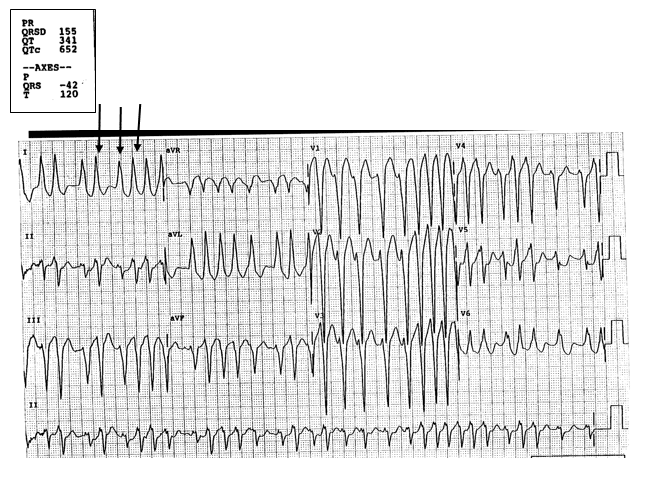Published on
Differential Diagnosis:
Inferior STEMI
Premature ventricular contractions (PVCs)
Ventricular tachycardia (VT)
Left bundle branch block (LBBB)
Atrial fibrillation with preexcitation (WPW)

Diagnosis
- The ECG reveals atrial fibrillation with preexcitation. What makes the ECG confusing is that the QRS complexes are wide, easily confused with ventricular tachycardia. The important qualifier is that the rhythm is “irregularly irregular. ” This is atrial fibrillation with preexcitation likely from Wolf-Parkinson-White (WPW)
- An inferior STEMI should have ST elevation in leads II, III, and aVF, often with reciprocal changes. PVCs and scattered and not continuous
- LBBB should have a wide QRS, but will be regular.
Learnings/What to Look for
- WPW is a supraventricular re-entrant rhythm which may have a normal rate or fast rate with findings of a delta wave, short PR interval, and prolonged QRS complex
- Atrial fibrillation is a supraventricular rhythm characterized by an irregularly irregular rhythm; it may be a normal rate or have a rapid ventricular response (RVR)
- Patients with atrial fibrillation have an increased risk of stroke (CVA), so consideration needs to be given for anticoagulation
- Inquire about signs of ischemia such as chest discomfort, shortness of breath, diaphoresis
- Assess for hemodynamic instability such as hypotension, dizziness, or confusion
Pearls for Initial Management and Considerations for Transfer
- Atrial fibrillation with WPW is a unique rhythm and is treated with procainamide. Typical AV nodal blockers may result in decompensation of the rhythm to ventricular fibrillation
- Unstable patients may require cardioversion
- Patient should be transported to the ED by EMS
- While awaiting EMS, place an IV (or two large-bore IVs) and put the patient on a monitor
A 52-Year-Old Man with Recent-Onset Dizziness
1 2
